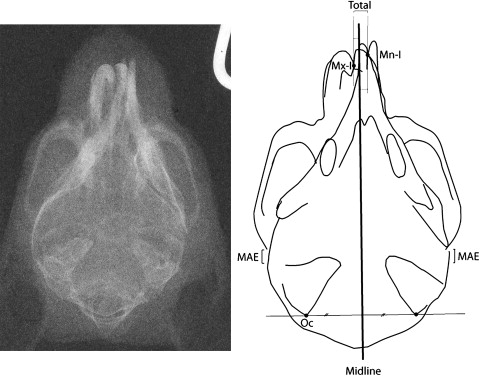Introduction
Mice with brachymorphism (bm) have defective chondrogenesis, including abnormal growth of the spheno-occipital synchondrosis. Malocclusion (anterior transverse crossbite) sometimes spontaneously occurs in inbred BALB/c- bm/bm mice, before the mandibular incisors erupt and make contact with the maxillary incisors. The aim of this study was to determine whether functional lateral loads to incisors promote anterior transverse crossbites in BALB/c- bm/bm mice.
Methods
BALB/c- bm/bm mice with normal occlusion (normal group), BALB/c- bm/bm mice with malocclusion in which the incisors were not cut (mal group), and BALB/c- bm/bm mice in which the incisors had been cut to eliminate the functional lateral load during continued growth (mal-cut group) were used. We examined the amounts of shift of the maxillary and mandibular incisors in each group using radiographic images.
Results
The amount of shift of the maxillary incisors in the mal group was significantly greater than that in normal group. The total amount of shift from the maxilla to the mandible in the mal group was significantly greater than in the normal and mal-cut groups.
Conclusions
The results suggest that a continuous functional lateral load to the incisors is strongly related to promoting and worsening anterior transverse crossbite in BALB/c- bm/bm mice.
Editor’s comment
One reason often given for early orthodontic treatment is to prevent functional problems from getting worse. We make that statement often, without any documentation that this is true, but it is intuitive.
Tsukamoto and colleagues in Japan set out to demonstrate the veracity of such an assumption, using mice that have a genetic basis for malocclusion. The mice have a mutation that results in impaired cartilage that often produces a lateral crossbite between the incisors. This crossbite is due to lateral shifting of both the maxillary and mandibular incisors, and it develops in some mice even before the incisors erupt. The authors divided the mice into those with normal occlusion and those with malocclusion as the incisors began to erupt, and then further divided the mice with malocclusion into 2 groups. They trimmed the incisors of 1 group before the incisors came into contact, so that the incisors did not shift farther because of the malocclusion. They measured the amounts of lateral shift of the maxillary and mandibular incisors on radiographs, and compared the amount of shift of each jaw as well as the combined lateral shift among all 3 groups.
The authors found that the amount of lateral displacement of the mandibular incisors was not significantly different between any of the 3 groups; however, the amount of shift of the maxillary incisors was significantly different between the normal and malocclusion groups when the incisors had not been trimmed. Mice with the incisors trimmed were not significantly different from normal mice. When the amounts of lateral displacement of the maxillary and mandibular incisors were combined, the amount was significantly greater in the malocclusion group with untrimmed incisors than in either the normal group or the malocclusion group with trimmed incisors.
This led the authors to conclude that “early improvement of occlusal interference that promotes malocclusion could prevent the malocclusion from becoming more severe in growing patients, even if they have genetic factors of malocclusion.”
Leslie Will





